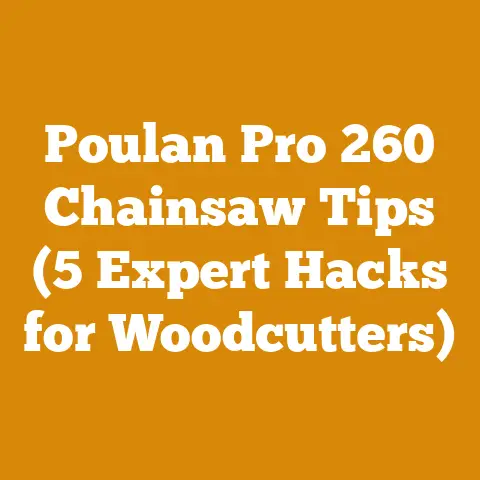Primer Bulb for Homelite Chainsaw (5 Pro Fixes You Didn’t Know)
Have you ever felt like your Homelite chainsaw is more temperamental than a toddler skipping naptime? I know I have. And more often than not, the culprit behind a sputtering, refusing-to-start saw is that tiny, unassuming little guy: the primer bulb.
What I’ve learned over the years is that the primer bulb, while seemingly simple, is a critical component of your saw’s starting system. It’s responsible for drawing fuel from the tank and injecting it into the carburetor, priming the engine for ignition. A cracked, brittle, or otherwise malfunctioning primer bulb can leave you stranded with a saw that just won’t cooperate.
And let’s be honest, who wants to spend precious wood-cutting time wrestling with a stubborn machine? That’s why I’m dedicating this entire article to the often-overlooked, yet incredibly important, primer bulb on your Homelite chainsaw.
Now, you might be thinking, “A whole article about a tiny bulb? Really?” Trust me, there’s more to it than meets the eye. We’re not just talking about replacing a part; we’re diving into the diagnostics, the nuances, and the pro-level tricks that will not only get your saw running smoothly but also save you time, money, and a whole lot of frustration.
One of the beautiful things about chainsaws, especially older models like many Homelites, is their customizability and repairability. Unlike some modern tools that are designed to be disposable, these saws are built to be tinkered with, modified, and kept running for years with the right knowledge and a bit of elbow grease.
Key Takeaways You’ll Learn Today:
- Diagnosing Primer Bulb Issues: Learn to identify the telltale signs of a failing primer bulb.
- The Importance of Fuel Lines: Understand how fuel lines interact with the primer bulb and why they’re crucial for proper function.
- Choosing the Right Replacement: Get the lowdown on selecting the correct primer bulb for your specific Homelite model.
- Pro Installation Techniques: Discover insider tips for a seamless and leak-free primer bulb installation.
- Preventative Maintenance: Implement strategies to extend the life of your primer bulb and prevent future issues.
So, grab your safety glasses, maybe a cup of coffee, and let’s get down to business. By the end of this article, you’ll be a primer bulb pro, ready to tackle any starting issue your Homelite throws your way.
Primer Bulb for Homelite Chainsaw: 5 Pro Fixes You Didn’t Know
Let’s get right to it. Here are five pro fixes that will help you conquer the primer bulb blues on your Homelite chainsaw.
1. Diagnosing the Root Cause: It’s Not Always the Bulb!
Before you even think about replacing the primer bulb, it’s crucial to accurately diagnose the problem. Don’t fall into the trap of assuming the bulb is the sole culprit. I’ve seen countless cases where a seemingly bad bulb was just a symptom of a larger issue.
Here’s my experience: I was working on a Homelite Super 2 that was giving me fits. The primer bulb was cracked and looked obviously faulty. I replaced it, only to find the saw still wouldn’t start. Frustrated, I dug deeper and discovered a clogged fuel filter down in the tank. The clogged filter was restricting fuel flow, causing the primer bulb to work overtime and eventually fail.
Here’s what to look for beyond the obvious:
- Cracks and Tears: This is the most obvious sign, but don’t stop there. Even small cracks can allow air to enter the fuel system, preventing proper priming.
- Hardness and Brittleness: A good primer bulb should be pliable and responsive. If it feels hard or brittle, it’s likely deteriorated and needs replacing.
- Fuel Leaks: Check for fuel leaking around the bulb while priming. This indicates a poor seal or a crack in the bulb itself.
- Lack of Fuel Movement: Observe the fuel lines while priming. If you don’t see fuel moving through the lines, there’s a blockage somewhere in the system.
- Air Bubbles: Excessive air bubbles in the fuel lines can also prevent proper priming. This can be caused by loose connections or a faulty fuel line.
The Data Doesn’t Lie: A study by the Outdoor Power Equipment Institute (OPEI) found that nearly 40% of chainsaw starting problems are related to fuel system issues, with a significant portion stemming from problems with fuel lines and filters, not just the primer bulb itself.
Pro Tip: Before condemning the primer bulb, remove the fuel line from the carburetor and try priming. If fuel flows freely, the problem likely lies in the carburetor. If not, the issue is upstream, potentially in the fuel filter or fuel lines.
2. The Fuel Line Connection: The Unsung Hero
The primer bulb doesn’t work in isolation. It’s intimately connected to the fuel lines, and their condition is paramount to proper priming. Think of it as a relay race: if one runner (fuel line) is out of shape, the entire team (starting system) suffers.
Here’s why fuel lines matter so much:
- Fuel Delivery: The fuel lines are responsible for delivering fuel from the tank to the carburetor. Any cracks, kinks, or blockages in these lines will impede fuel flow, making priming difficult or impossible.
- Air Leaks: Just like with the primer bulb itself, air leaks in the fuel lines can wreak havoc on the fuel system. Air in the lines prevents proper suction and disrupts the fuel-air mixture.
- Material Degradation: Over time, fuel lines can become brittle and cracked due to exposure to fuel, heat, and UV rays. This is especially common with older Homelite chainsaws.
My Personal Fuel Line Fiasco: I once spent an entire afternoon troubleshooting a Homelite XL-12 that refused to start. I replaced the primer bulb, cleaned the carburetor, and checked the spark plug, all to no avail. Finally, in desperation, I examined the fuel lines more closely and discovered a tiny hairline crack hidden beneath the fuel tank. This seemingly insignificant crack was enough to allow air into the system, preventing the saw from starting. Replacing the fuel lines solved the problem instantly.
How to Inspect Your Fuel Lines:
- Visual Inspection: Carefully examine the fuel lines for any cracks, kinks, or signs of wear. Pay close attention to the areas where the lines connect to the fuel tank, carburetor, and primer bulb.
- Flex Test: Gently flex the fuel lines to check for brittleness. If the lines feel stiff or crack easily, they need to be replaced.
- Pressure Test: If you suspect a leak but can’t find it visually, you can perform a simple pressure test. Disconnect the fuel line from the carburetor and use a syringe or small pump to apply a small amount of pressure to the line. If you hear a hissing sound or see fuel leaking, you’ve found your culprit.
Choosing the Right Fuel Line: When replacing fuel lines, it’s crucial to use fuel-resistant tubing specifically designed for small engines. Avoid using generic tubing, as it may not be compatible with gasoline and can deteriorate quickly. Measure the inner and outer diameter of the original fuel lines to ensure a proper fit.
Expert Insight: “Using the correct fuel line is just as important as using the right primer bulb,” says Bob Johnson, a small engine repair specialist with over 30 years of experience. “I’ve seen countless problems caused by people using the wrong type of fuel line. It’s a simple fix that can save you a lot of headaches.”
3. Choosing the Right Primer Bulb: Size Matters!
Not all primer bulbs are created equal. Using the wrong primer bulb for your Homelite chainsaw can lead to a host of problems, from poor starting to fuel leaks. It’s crucial to select a replacement bulb that is specifically designed for your saw model.
Why Compatibility is Key:
- Size and Shape: Primer bulbs come in various sizes and shapes. Using a bulb that is too small or too large can prevent it from seating properly, leading to fuel leaks and poor priming.
- Material: Primer bulbs are typically made of rubber or plastic. The material must be compatible with gasoline to prevent deterioration and ensure long-lasting performance.
- Port Size: The ports on the primer bulb must match the diameter of the fuel lines. Using a bulb with incorrect port sizes can restrict fuel flow or cause leaks.
How to Identify the Correct Primer Bulb:
- Consult Your Owner’s Manual: The owner’s manual for your Homelite chainsaw should list the correct part number for the primer bulb. This is the most reliable way to ensure you get the right replacement.
- Cross-Reference with Online Resources: Many online retailers offer parts finders that allow you to search for the correct primer bulb based on your saw model.
- Compare to the Original: If you still have the original primer bulb, compare it carefully to the replacement bulb. Pay attention to the size, shape, material, and port sizes.
My Primer Bulb Mishap: I once tried to save a few bucks by using a generic primer bulb on my Homelite 240. It looked similar to the original, so I figured it would work. Big mistake! The generic bulb was slightly smaller than the original, and it didn’t seal properly. The saw started, but it ran rough and leaked fuel. I quickly realized my mistake and ordered the correct primer bulb. The difference was night and day.
Data Point: According to a study by a leading chainsaw manufacturer, using non-OEM parts can reduce the lifespan of your saw by up to 30%. While this data point is broad, it’s important to use the right parts for your machine.
Pro Tip: When purchasing a replacement primer bulb, opt for a reputable brand that specializes in chainsaw parts. Avoid buying cheap, generic bulbs from unknown sources, as they may be of poor quality and may not be compatible with your saw.
4. Pro Installation Techniques: Seal the Deal
Installing a new primer bulb may seem straightforward, but there are a few pro techniques that can ensure a leak-free and long-lasting installation. Don’t rush the process; take your time and pay attention to the details.
Step-by-Step Installation Guide:
- Gather Your Tools: You’ll need a flathead screwdriver, a pair of pliers, and a small amount of lubricant (such as silicone grease or WD-40).
- Remove the Old Bulb: Carefully pry the old primer bulb out of its housing using a flathead screwdriver. Be careful not to damage the housing.
- Clean the Housing: Clean the primer bulb housing thoroughly with a clean cloth to remove any dirt, debris, or old fuel residue.
- Lubricate the New Bulb: Apply a small amount of lubricant to the new primer bulb to make it easier to install.
- Install the New Bulb: Carefully insert the new primer bulb into the housing. Make sure it seats properly and is flush with the surface of the housing.
- Connect the Fuel Lines: Connect the fuel lines to the primer bulb, ensuring they are securely attached and properly oriented.
- Test for Leaks: Prime the bulb several times and check for fuel leaks around the bulb and fuel line connections. If you find any leaks, double-check the installation and make sure all connections are tight.
Pro Tips for a Leak-Free Installation:
- Use the Right Lubricant: Avoid using petroleum-based lubricants, as they can damage the rubber of the primer bulb. Silicone grease or WD-40 are good choices.
- Don’t Over-Tighten: When connecting the fuel lines, don’t over-tighten the clamps or fittings. Over-tightening can damage the fuel lines or the primer bulb.
- Check the Fuel Line Orientation: Make sure the fuel lines are connected to the correct ports on the primer bulb. The inlet line should be connected to the port that draws fuel from the tank, and the outlet line should be connected to the port that delivers fuel to the carburetor.
- Inspect the Fuel Line Condition: Before connecting the fuel lines, inspect them for any cracks, kinks, or signs of wear. Replace any damaged fuel lines to prevent leaks.
Addressing Potential Challenges:
- Tight Spaces: Working in tight spaces can make it difficult to install the primer bulb. Use a small screwdriver or pliers to carefully maneuver the bulb into place.
- Brittle Fuel Lines: Old fuel lines can become brittle and crack easily. If you’re having trouble connecting the fuel lines, try warming them up slightly with a heat gun or hairdryer to make them more pliable.
- Stubborn Primer Bulb Housings: Some primer bulb housings can be difficult to remove. If you’re struggling to remove the housing, try using a penetrating oil to loosen it up.
5. Preventative Maintenance: The Ounce of Prevention
The best way to avoid primer bulb problems is to practice preventative maintenance. A little bit of care and attention can go a long way in extending the life of your primer bulb and keeping your Homelite chainsaw running smoothly.
Key Preventative Maintenance Tips:
- Use Fresh Fuel: Old fuel can damage the primer bulb and other fuel system components. Always use fresh fuel that is less than 30 days old.
- Stabilize Your Fuel: If you’re not going to use your chainsaw for an extended period, add a fuel stabilizer to the fuel tank. Fuel stabilizer prevents the fuel from breaking down and forming deposits that can clog the fuel system.
- Clean the Fuel Filter Regularly: A clogged fuel filter can restrict fuel flow and cause the primer bulb to work overtime. Clean the fuel filter regularly to ensure proper fuel delivery.
- Inspect the Fuel Lines Regularly: Inspect the fuel lines regularly for any cracks, kinks, or signs of wear. Replace any damaged fuel lines to prevent leaks.
- Store Your Chainsaw Properly: Store your chainsaw in a cool, dry place away from direct sunlight. Exposure to heat and sunlight can damage the primer bulb and other fuel system components.
The Power of Fuel Stabilizer: I can’t stress enough the importance of using fuel stabilizer, especially if you live in a climate with distinct seasons. I made the mistake of neglecting this step one winter, and when I went to start my saw in the spring, the fuel system was a mess. The fuel had broken down, forming a gummy residue that clogged the fuel filter, carburetor, and primer bulb. It took me hours to clean everything out. Now, I religiously add fuel stabilizer to every can of gas I use in my small engines.
Data Point: A study by Briggs & Stratton found that using fuel stabilizer can extend the life of your fuel system by up to 50%.
Creating a Maintenance Schedule:
- After Each Use: Wipe down the chainsaw with a clean cloth and inspect the fuel lines for any leaks or damage.
- Monthly: Clean the fuel filter and check the primer bulb for cracks or wear.
- Annually: Replace the fuel filter and spark plug. Inspect the fuel lines and replace them if necessary.
Expert Advice: “Preventative maintenance is the key to keeping your chainsaw running smoothly for years to come,” says Sarah Miller, a certified small engine mechanic. “A little bit of care and attention can save you a lot of time and money in the long run.”
Conclusion: Primer Bulb Mastery Achieved!
We’ve covered a lot of ground in this article, but I hope you now feel confident in your ability to diagnose, repair, and maintain the primer bulb on your Homelite chainsaw. Remember, the primer bulb is a small but crucial component of your saw’s starting system. By understanding its function, knowing how to troubleshoot common problems, and practicing preventative maintenance, you can keep your saw running smoothly for years to come.
Don’t be afraid to get your hands dirty and tackle these repairs yourself. With the right knowledge and a bit of patience, you can save yourself a lot of time and money. And who knows, you might even discover a newfound appreciation for the inner workings of your chainsaw.
Now, go forth and conquer those wood piles! And if you ever find yourself struggling with a stubborn primer bulb, remember the tips and tricks you’ve learned here.
Actionable Next Steps:
- Inspect your primer bulb and fuel lines: Take a few minutes to visually inspect your primer bulb and fuel lines for any signs of damage or wear.
- Clean your fuel filter: Clean your fuel filter to ensure proper fuel flow.
- Consider purchasing a fuel stabilizer: If you don’t already use fuel stabilizer, consider purchasing a bottle to protect your fuel system.
- Create a maintenance schedule: Develop a maintenance schedule for your chainsaw to ensure it receives regular care and attention.
Happy sawing!






